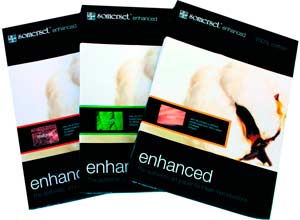articles/Paper/reviewsomersetpaper-page1
Review Somerset Paper - part 1 of 1 2
by Mike McNamee Published 01/08/2002

St Cuthberts Mill are a well established fine art paper maker with a long-standing tradition in the manufacture of high quality papers. With such an evocative name and coming out of the cathedral city of Wells, it's small wonder that the product has always done well in the USA. Somerset is a name well known to the water colourist and print makers and now a range of three inkjet papers has been created by taking the St Cuthbert's mould making skills that go back for centuries and adding a 21st century coating for the inkjet media. The papers are called Somerset Enhanced with a Satin, Velvet or Textured tag to denote the surface properties. They carry the hallmarks of mould making with subtle variations between sheets and batches depending upon the state of the velvet of the mould papermaking machine.
General Properties
All three papers are 225gsm weight, around 40microns in thickness. Made from 100% cotton rag, acid free and calcium carbonate buffered, they have truely archival properties. They have a soft feel to the touch and a smooth undulating surface texture which becomes progressively more pronounced from Satin through Velvet to Textured. There does not appear to be any significant amount of optical brightener in the coating as measured by UV Light and the spectrophotometer. The actual base colour was a little difficult to pin down. In comparison to Tetenal Duo Print (a heavily optically brightened material), the paper is a very delicate cream in Northern Sky Daylight but neutral looking in both daylight, D65, light and Tungsten light. The spectrophotometer confirmed this observation although the Somerset papers were all brighter than the Tetenal by some 5%, which was a considerable surprise. Instrumental measurement rated the Somerset paper almost totally neutral. All the papers loaded into Epson printers without too much difficulty, even though they are over the regulation thickness for some of these printers. We found it best to use the paper form feed before commencing printing so that we could be sure that transport had been made correctly. The 1270's seemed to need a couple of attempts on average, the rest loaded almost without problem.q

Somerset papers do not contain optical brighteners and so do not fluoresce in UV light.
Space does not permit us to show all the review data but we have given the Somerset papers a very thorough examination, using Epson 1270, 1290, 2000, 2100, and 950 printers as well as Epson and Generations Microbright inks. We have used the paper for commercial portraits, national and international exhibitions and yes, we like it a lot!
Somerset Velvet Enhanced With the Epson 1290
This paper was tested under a variety of printer media setting and generally confirmed the overall findings of a blue bias in the high to middle tones. The use of Photo Quality Glossy Film media setting pushed the bias towards magenta. All Somerset papers were generally more blue (and less cyan) in the mid tones that the other papers we have tested on the 1290. We elected to use the Photo Paper setting as standard. This is the received wisdom for profiling work as it is used by Epson as their base setting. The progression down the grey scale was good with excellent separation in the highlights and shadows. The maximum black was 15.3%. Detail was well held with the ink dots still just visible under the loupe.
You are currently on page 1 Contact Mike McNamee
1st Published 01/08/2002
last update 09/12/2022 14:58:35
More Paper Articles
There are 0 days to get ready for The Society of Photographers Convention and Trade Show at The Novotel London West, Hammersmith ...
which starts on Wednesday 15th January 2025





